Mobile Ivy Bridge and ASUS N56VM Preview
by Jarred Walton on April 23, 2012 12:02 PM ESTThe LCD: One of the Better Offerings
There are a few things we need to reiterate with the LCD before we run the numbers. First, this is a good panel from LG—it’s the LP156WF1 (A1). You get a matte surface, 1080p resolution, decent color gamut (exceeding the sRGB color space), and a maximum brightness that can certainly be used outdoors. That’s all great, but there’s a catch: we don’t know if this panel will actually ship on all, some, or none of the N56VM models. We hope it’s the first option, but most likely it will be the second, and we’ll be very unhappy if the 1080p panel gets pulled in favor of a cheaper 1366x768 display. So while we’ll present the numbers below, just make sure you check on the panel resolution if nothing else before purchasing a retail N56VM laptop. With that out of the way, here’s how the LG Philips display compares to other LCDs.
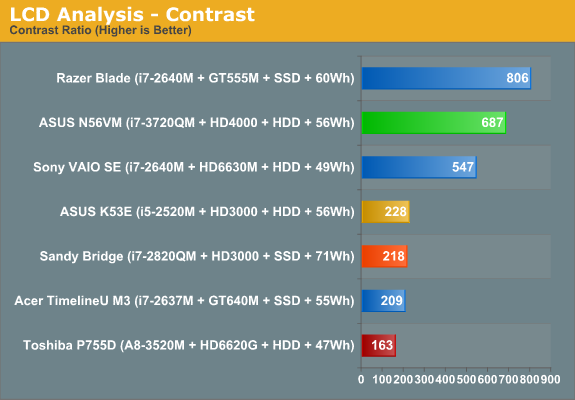

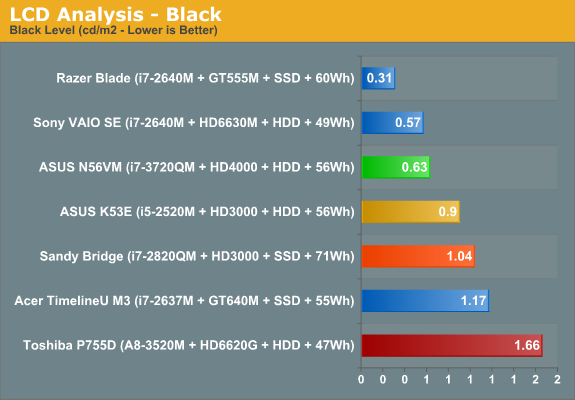
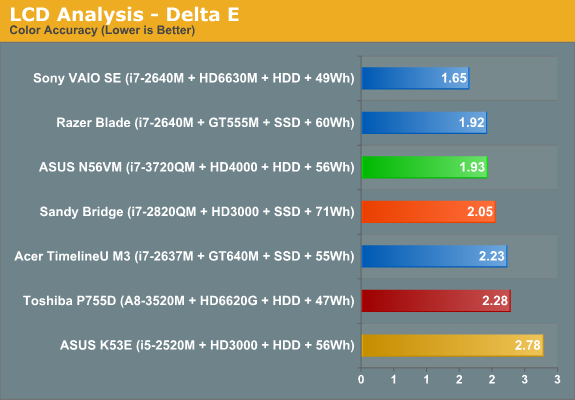
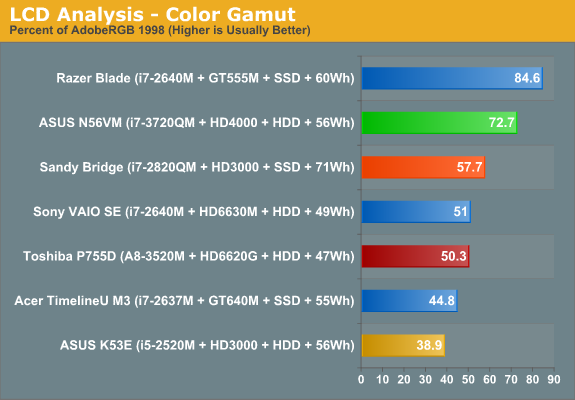
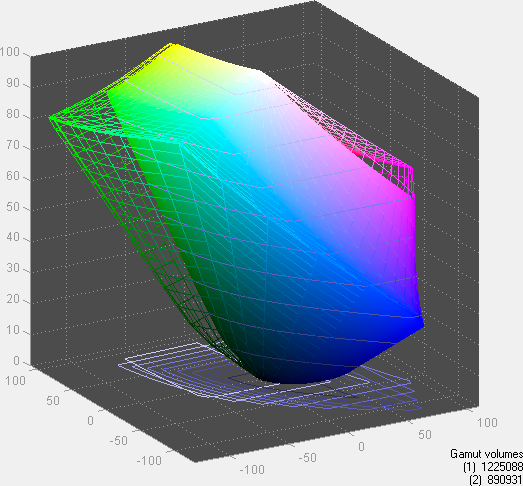
Overall, this is a well balanced LCD for a 15.6” laptop. It can get very bright, which is always a plus for laptops that might be used outside or on public transportation, the contrast is good, and the colors are good as well. The AU Optronics B156HW01 v4 is still a better LCD in some regards, with a higher color gamut and better post-calibration colors, but we wouldn’t complain about using the LP156WF1.
Viewing angles aren’t quite as good as the AUO display either, but outside of IPS, PLS, or *VA panels you simply won’t get excellent vertical viewing angles. And there’s the rub: the IPS display used in the Sony VAIO SE and HP Envy 15 has great viewing angles, but color gamut is a bit low and that results in colors that aren’t quite as good as a high-end TN panel, at least in theory. The problem is that TN panels get color shift unless you’re in a narrow viewing arc, so ultimately we prefer the wide viewing angles of IPS even if it means slightly lower scores elsewhere.















49 Comments
View All Comments
JarredWalton - Tuesday, May 1, 2012 - link
Ivy Bridge is technically capable of supporting three displays, but it needs three TMDS transceivers in the laptop (or on the desktop motherboard) to drive the displays simultaneously. Some laptop makers will likely save $0.25 or whatever by only including two, but others will certainly include the full triple head support.JarredWalton - Thursday, May 10, 2012 - link
Just a quick correction, in case anyone is wondering:For triple displays, Ivy Bridge needs to run TWO of the displays off of DisplayPort, and the other can be LVDS/VGA/HDMI/DVI. I can tell you exactly how many laptops I've seen with dual DP outputs: zero. Anyway, it's an OEM decision, and I'm skeptical we'll see 2xDP any time soon.
JarredWalton - Tuesday, April 24, 2012 - link
"I'm not sure what your point is, at all"? You cannot be serious. Either you have no understanding of thermodynamics, or you're just an anonymous Internet troll. I don't know what your problem is, rarson, but your comments on all the Ivy Bridge articles today are the same FUD with nothing to back it up.Ivy Bridge specifications allow for internal temperatures of up to 100C, just like most other Intel chips. At maximum load the chip in the N56VM hits 89C, but it's doing that with the fan hardly running at all and generating almost no noise compared to other laptops. Is that so hard to understand? A dual-core Sandy Bridge i7-2640M in the VAIO SE hits higher temperatures while generating more noise. I guess that means Sandy Bridge is a hot chip in your distorted world view? But that would be wrong as well. The reality is that the VAIO SE runs hot and loud because of the way Sony designed the laptop, and the N56VM runs hot and quiet because of the way ASUS designed the laptop.
The simple fact is Ivy Bridge in this laptop runs faster than Sandy Bridge in other laptops, even at higher temperatures than some laptops that we've seen. There was a conscious decision to let internal CPU temperatures get higher instead of running the fans faster and creating more noise. If the fan were generating 40dB of noise, I can guarantee that the chip temperature wouldn't be 89C under load. Again, this is simple thermodynamics. Is that so difficult to understand?
How do we determine what Ivy Bridge temperatures are like "in general"? How do you know that it's a "hot chip"? You don't, so you're just pulling stuff out of the air and making blanket statements that have no substance. It seems you either work for AMD and think you're doing them a favor with these comments (you're not), or you have a vendetta against Intel and you're hoping to make people in general think Ivy Bridge is bad just because you say so (it's not).
mtoma - Tuesday, April 24, 2012 - link
I really don't want to play dumb - but if I get an honest answer I'll be pleased: Jarred said that the panel used in Asus N56VM is an LG LP156WF1. OK - how can I find the display type in a specific laptop? I have a Lenovo T61 and... I need help. I want to know the manufacturer, display type, viewing angles. Thanks!JarredWalton - Tuesday, April 24, 2012 - link
I use Astra32 (www.astra32.com), a free utility that will usually report the monitor type. However, if the OEM chooses to overwrite the information in the LCD firmware, you'll get basically a meaningless code. You can also look at LaptopScreen.com and see if they have the information/screen you need (http://www.laptopscreen.com/English/model/IBM-Leno...leovande321 - Wednesday, May 15, 2013 - link
AUO 10.1 "SD + B101EVT03.2 1280X800 Matte Laptop Screen Grade A +I hope to help you!!!
AUO BOE CMO CPT IVO 10.1 14.0 15.6 LED CCFL whoalresell
Wholesale Laptop Screens www.globalresell.com
Spunjji - Thursday, April 26, 2012 - link
Calm down there. His comment is pointing out that measuring the temperatures of this laptop will tell you nothing about how hot mobile Ivy Bridge is as a platform. We need more information. It looks like it's not as cool as Intel marketing want everyone to believe, but we just don't know yet.JarredWalton - Thursday, April 26, 2012 - link
The real heart of the matter is that more performance (IVB) just got stuffed into less space. 22nm probably wasn't enough to dramatically reduce voltages and thus power, so the internal core temperatures are likely higher than SNB in many cases, even though maximum power draw may have gone down.For the desktop, that's more of a concern, especially if you want to overclock. For a laptop, as long as the laptop doesn't get noisy and runs stable, I have no problem with the tradeoff being made, and I suspect it's only a temporary issue. By the time ULV and dual-core IVB ship, 22nm will be a bit more mature and have a few more kinks ironed out.
leovande321 - Wednesday, May 15, 2013 - link
AUO 10.1 "SD + B101EVT03.2 1280X800 Matte Laptop Screen Grade A +I hope to help you!!!
AUO BOE CMO CPT IVO 10.1 14.0 15.6 LED CCFL whoalresell
Wholesale Laptop Screens www.globalresell.com
raghu78 - Wednesday, May 2, 2012 - link
Even though you have mentioned that 45w Llano would have improved the gaming performance it would have been better to include such a configuration in your testing. Given that you were testing a 45w high end next gen core i7 product which itself skews the balance in Intel's favour given the vast difference in CPU processing capability the least you could have done was put a similar wattage AMD Llano SKU. The result would be that other than Batman and Skyrim the rest would all be better on HD 6620G. As they say "a picture is worth a thousand words ". All your charts cannot be undone by a small note at the end of the charts. The damage has been done.This is my opinion that objective comparisons can only be made under similar parameters. Its even more critical in the notebook market which have strict thermal restrictions. The desktop market is slightly less restrictive except for HTPCs which need 65w or lesser processors. When the comparisons for Trinity 35w are made it should be against 35w Ivybridge core i3 and core i5. By benching a ivybridge core i7 with a 45w rating and comparing with a Trinity 35w we aren't making a fair and objective comparison. Also the fact that the ivybridge core i7 and trinity are not in the same price segment makes things worse. I hope my comments are not taken negatively.